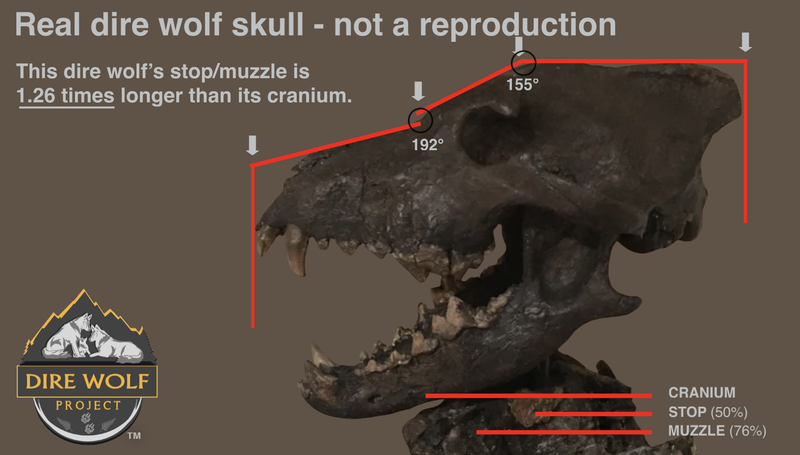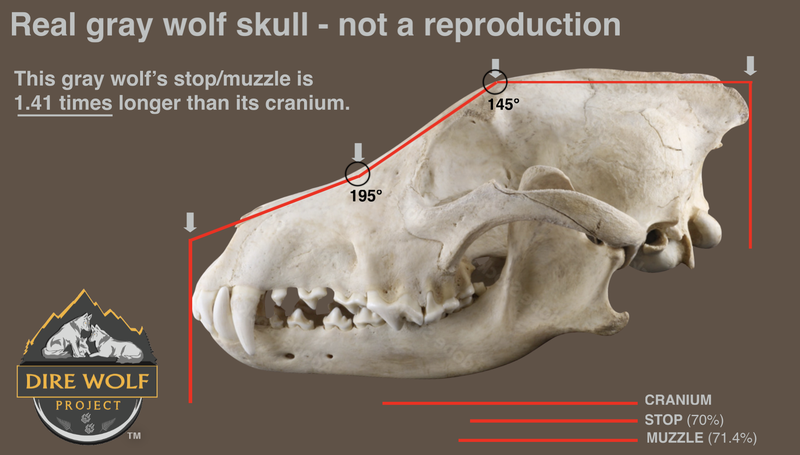Dire Wolf vs. Gray Wolf Skull Comparisons
The cranial morphology of apex predators offers profound insights into their ecological roles, prey selection, and evolutionary strategies. Here, we compare the skulls of the gray wolf (Canis lupus) and the Pleistocene dire wolf (Aenocyon dirus), quantifying relative cranial proportions, slope angles, and structural adaptations. Our analysis reveals that the gray wolf’s elongated, gracile snout favors versatility and endurance hunting, whereas the dire wolf exhibits a shorter, straighter, and more robust cranial architecture optimized for bone-crushing and grappling with large Pleistocene megafauna. These findings are further contextualized in the design philosophy of the American Dirus dog, which embodies the reinforced bite morphology of the dire wolf rather than the slender precision of modern gray wolf hybrids.


Let's review the comparisons between the two.
1. Relative Length Ratios: Stop and Muzzle

The gray wolf exhibits a proportionally longer snout complex, implying adaptations toward speed, agility, and versatility across prey types. In contrast, the dire wolf’s shorter snout relative to cranium length signals a specialization toward megafaunal predation, where raw crushing power and stress-resistant jaws were essential.
2. Cranium-to-Stop Angle (Cranial Slope)

The dire wolf’s cranial slope creates a more abrupt transition from forehead to muzzle, an architectural feature supporting repetitive stress resistance in bone-crushing feeding behavior. The gray wolf’s smoother slope facilitates a versatile, endurance-oriented predation strategy.
3. Stop-to-Muzzle Angle (Facial Slope)

This facial slope comparison further highlights ecological divergence: the gray wolf’s tapered muzzle aids in capturing agile prey, while the dire wolf’s straighter profile emphasizes structural integrity for subduing large, struggling prey.
4. Evolutionary Implications
Gray wolf (C. lupus):
- Elongated snout, narrower slopes
- Generalist predation strategy: endurance running, adaptability, and precision targeting of medium-sized prey
Dire wolf (A. dirus):
- Shorter, reinforced snout, straighter slopes
- Specialist predation strategy: high bite force, bone-crushing capability, optimized for megafaunal prey
In essence, the gray wolf evolved as a lightweight spear, quick, precise, and versatile. The dire wolf evolved as a warhammer, blunt, devastating, and mechanically robust.
Imagine the rolling plains and glacial-edge forests of the Late Pleistocene. The gray wolf, lean and elegant, threads through the underbrush, eyes locked on a fleet-footed deer. Every stride measures distance, every jaw snap timed to perfection — endurance and agility define its hunting success.
Meanwhile, the dire wolf stalks in packs over frozen expanses, muscles taut with latent power. Its eyes lock on a massive bison, its jaws a fortress of bone-crushing might. When the pack descends, the battle is swift and forceful; bones splinter, sinew tears, and survival tilts in favor of raw strength. Where the gray wolf dances with its prey, the dire wolf dominates.
At the Dire Wolf Project™, we do not seek to emulate the lithe gray wolf of modern hybrid fame. Our breeding philosophy honors the mighty A. dirus, emphasizing:
- Broad, reinforced cranial structure
- Enhanced bite force (approximately 142% stronger than the average gray wolf)
- Subtle cranial angles promoting resilience and power
American Dirus™ dogs embody the dire wolf’s strength and adaptability to human companionship — a living homage to the apex predators of the Ice Age. Their skull morphology supports not just aesthetic homage but functional capability, combining stability, bite power, and the silent majesty of a creature evolved for survival on a grand scale.
Through comparative cranial analysis, we observe a fundamental divergence in evolutionary strategy between the gray wolf and the dire wolf. Gray wolves — precision hunters, endurance specialists — contrast sharply with the bone-crushing, megafauna-focused dire wolves. This divergence is reflected in the American Dirus dogs bred at the Dire Wolf Project™, who carry the hallmark robust skull, reinforcing a living lineage inspired by Ice Age predators rather than contemporary hybrid wolves. Where one thrives on finesse, the other thrives on force — a warhammer echoing through millennia.
Follow our work. Join our Inner Circle and become a part of the adventure to breed back the world's first domesticated dire wolf replica without using any modern wolf content.
100% Dog, 0% Wolf™